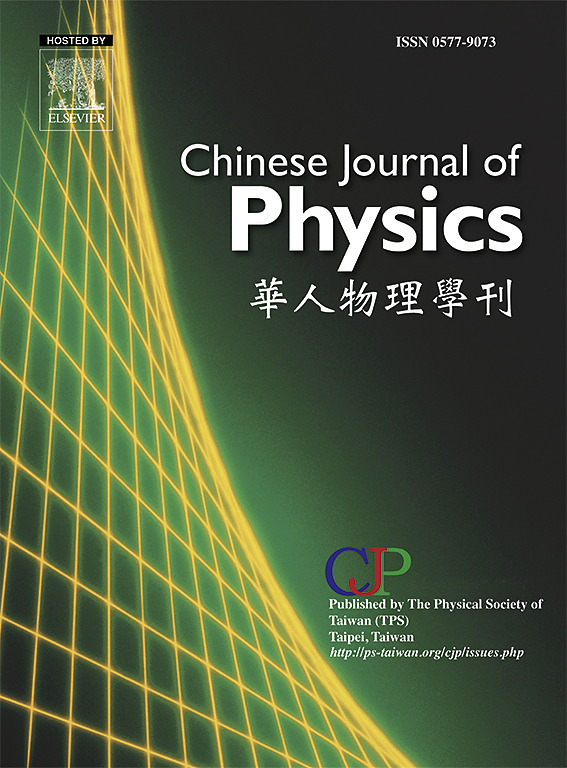Lattice boltzmann method for mixed convection with non-uniform and fractal Al2O3/water nanofluid in differently vertical moving lid cavities
IF 4.6
2区 物理与天体物理
Q1 PHYSICS, MULTIDISCIPLINARY
引用次数: 0
Abstract
Mesoscale Lattice Boltzmann simulation is used to solve the mixed convection of Al2O3/H2O nanofluid medium in two-sided lid-driven cavities. Flow governing equations like Navier-Stokes and energy equations in the form of particle distribution functions have been solved by the Lattice Boltzmann Method (LBM). The effect of fractal dimension (minimum to maximum diameter) and non-uniform diameter of Al2O3 nanoparticles for different concentrations in water inside the cavities has been considered. Based on the vertical walls motion, three different cases of lid-driven problems have been considered. First, only the left wall is moving in the upward direction (Case-I), second, when the vertical walls are moving in the same direction (Case-II), and third, when the vertical walls are moving in the opposite direction (Case-III). Results are depicted in the form of streamline, isotherms, Nusselt number, and vertical velocity variation. A significant decrease in Nusselt number is found for the range of mean nanoparticle diameter from 1 nm to 20 nm. Increasing the fractal dimension of Al2O3 increases the heat transfer in all three different cases. Fractal distribution R = 0.001 has the capability of a lower heat transfer rate than at R = 0.007. Quantitatively a maximum of 51 % increment in for Case III is observed in comparison to Case I at Ri = 0.1 for the same parameters. This increment is 46 % for Case II in comparison to Case I, which is observed. Case-III with a higher value of fractal distribution and smaller mean diameter of nanoparticles is suggested for better heat transfer.

不同垂直运动盖腔中非均匀分形Al2O3/水纳米流体混合对流的晶格玻尔兹曼方法
采用中尺度晶格玻尔兹曼模拟方法求解了Al2O3/H2O纳米流体介质在双面盖驱动腔内的混合对流问题。用点阵玻尔兹曼方法(LBM)求解了以粒子分布函数形式表示的Navier-Stokes流控制方程和能量方程。考虑了不同浓度Al2O3纳米颗粒在空腔内水中的分形维数(最小到最大直径)和非均匀直径的影响。基于垂直壁面运动,考虑了三种不同情况下的井盖驱动问题。第一种情况是只有左壁向上移动(Case-I),第二种情况是垂直壁向同一方向移动(Case-II),第三种情况是垂直壁向相反方向移动(Case-III)。结果以流线、等温线、努塞尔数和垂直速度变化的形式描述。在平均纳米颗粒直径1 ~ 20 nm范围内,努塞尔数显著减小。增加Al2O3的分形维数可以增加三种不同情况下的换热。分形分布R = 0.001比R = 0.007具有更低的换热率。在相同的参数下,在Ri = 0.1的情况下,与情况I相比,在数量上观察到情况III的最大增量为51%。与观察到的情况1相比,情况2的增量为46%。分形分布值越大、颗粒平均直径越小的Case-III型传热效果越好。
本文章由计算机程序翻译,如有差异,请以英文原文为准。
求助全文
约1分钟内获得全文
求助全文
来源期刊

Chinese Journal of Physics
物理-物理:综合
CiteScore
8.50
自引率
10.00%
发文量
361
审稿时长
44 days
期刊介绍:
The Chinese Journal of Physics publishes important advances in various branches in physics, including statistical and biophysical physics, condensed matter physics, atomic/molecular physics, optics, particle physics and nuclear physics.
The editors welcome manuscripts on:
-General Physics: Statistical and Quantum Mechanics, etc.-
Gravitation and Astrophysics-
Elementary Particles and Fields-
Nuclear Physics-
Atomic, Molecular, and Optical Physics-
Quantum Information and Quantum Computation-
Fluid Dynamics, Nonlinear Dynamics, Chaos, and Complex Networks-
Plasma and Beam Physics-
Condensed Matter: Structure, etc.-
Condensed Matter: Electronic Properties, etc.-
Polymer, Soft Matter, Biological, and Interdisciplinary Physics.
CJP publishes regular research papers, feature articles and review papers.
 求助内容:
求助内容: 应助结果提醒方式:
应助结果提醒方式:


